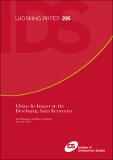| dc.description.abstract | The rapid growth of East Asia, with China at its centre, has attracted global
attention. Many authors have emphasised the emergence of regional production
systems and the spread of high rates of growth across a large number of Asian
economies. Nevertheless, the East Asian regional production system has not
benefited all countries in the region equally. The more advanced Asian economies
(Hong Kong, Singapore, South Korea and Taiwan) and the ASEAN-4 economies
(Malaysia, Indonesia, Thailand and the Philippines) have a very different economic
relationship in China compared with the poorer countries of the Greater Mekong
Subregion (Cambodia, Laos, Myanmar and Vietnam). While the former have
benefited from complementarities with China, supplying parts and components to
largely export-oriented assembly plants, the latter are selling raw materials and
resource-based products to China.
China’s growth offers many opportunities for other Asian countries to accelerate
their growth. Making use of these opportunities for purposes of income generation
of poor people requires prioritising two policy areas. The first is connectivity. Some
parts of Asia remain poorly connected to this regional production system. Better
infrastructure and better trade links are key to enhancing the growth and incomes
in these parts of Asia. The second priority is enhancing sustainability. The poorer
Asian countries have increased exports to China, but much of this resource-based
export growth is unsustainable. Sustaining and increasing trade between China and
these countries has the potential to be more effective than increasing aid for the
pursuit of poverty reduction and improved welfare in the poorer countries of the
region. However, these countries will only benefit from the dynamism of the East
Asian regional economy if policy initiatives directly address the issue of sustainability
of resource extraction. These initiatives need to be taken not only in the exporting
countries, but also in China itself.
Keywords: regional integration; value chains; East Asia; economic development. | en_GB |

